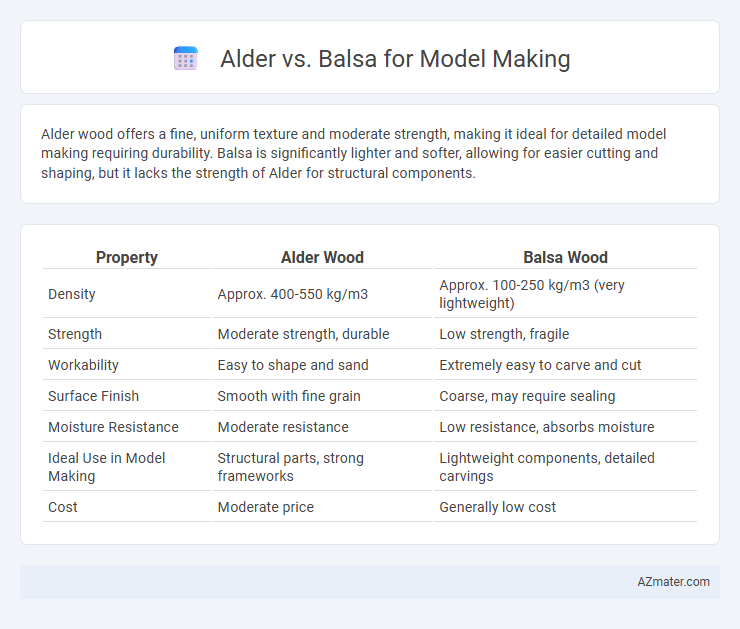Alder wood offers a fine, uniform texture and moderate strength, making it ideal for detailed model making requiring durability. Balsa is significantly lighter and softer, allowing for easier cutting and shaping, but it lacks the strength of Alder for structural components.
Table of Comparison
| Property | Alder Wood | Balsa Wood |
|---|---|---|
| Density | Approx. 400-550 kg/m3 | Approx. 100-250 kg/m3 (very lightweight) |
| Strength | Moderate strength, durable | Low strength, fragile |
| Workability | Easy to shape and sand | Extremely easy to carve and cut |
| Surface Finish | Smooth with fine grain | Coarse, may require sealing |
| Moisture Resistance | Moderate resistance | Low resistance, absorbs moisture |
| Ideal Use in Model Making | Structural parts, strong frameworks | Lightweight components, detailed carvings |
| Cost | Moderate price | Generally low cost |
Introduction to Alder and Balsa Woods
Alder wood, known for its fine grain and moderate hardness, offers excellent stability and ease of shaping, making it a preferred choice for detailed model making. Balsa wood, recognized as the lightest hardwood with a soft, porous texture, provides superior buoyancy and ease of cutting, ideal for lightweight structural components. Both woods present unique benefits: alder delivers durability and a smooth finish, while balsa excels in weight-sensitive applications requiring rapid assembly.
Physical Properties Comparison
Alder wood is denser and harder than balsa, providing better durability and structural strength for model making. Balsa is exceptionally lightweight with low density, making it ideal for models requiring easy shaping and minimal weight. Both woods have fine grain, but alder's rigidity supports detailed work, while balsa excels in projects prioritizing lightweight material.
Weight and Density Differences
Alder wood typically has a density of approximately 400 kg/m3, making it heavier and denser compared to balsa, which can have a density as low as 160 kg/m3. This significant difference in weight affects model making, where balsa's lightweight properties provide easier shaping and enhanced buoyancy for models requiring minimal mass. Conversely, alder's higher density offers greater strength and durability, suitable for models that demand structural integrity over weight savings.
Workability and Ease of Shaping
Alder wood offers moderate workability with a fine, even grain that allows for smooth cutting, sanding, and carving, making it suitable for detailed model making. Balsa is known for its exceptional ease of shaping due to its ultra-lightweight and soft texture, allowing modelers to quickly carve and sand complex forms with minimal effort. While Alder provides durability and a smoother finish, Balsa's superior softness and flexibility make it the preferred choice for rapid prototyping and intricate model designs.
Strength and Durability Analysis
Alder wood offers greater strength and durability compared to balsa, making it suitable for model components requiring structural integrity and resistance to damage. Balsa, while significantly lighter and easier to shape, lacks the same level of impact resistance and long-term durability, often limiting its use to non-load-bearing parts. Choosing alder enhances the model's longevity and robustness, especially in applications subjected to frequent handling or environmental stress.
Surface Finish and Paintability
Alder wood offers a smoother surface finish compared to Balsa, making it ideal for detailed model making that requires fine sanding and crisp edges. Its tighter grain structure enhances paint adhesion, resulting in a more even and durable paint layer. Balsa's porous texture absorbs paint unevenly, often necessitating a primer coat for optimal paintability and a uniform finish.
Cost and Availability
Alder wood tends to be more expensive than balsa due to its denser grain and higher durability, making it a pricier option for model making. Balsa is widely available and cost-effective, favored by hobbyists for its lightweight properties and easy workability. The abundant supply of balsa wood in craft stores ensures lower prices and consistent accessibility compared to the more specialized sourcing needed for alder.
Popular Model Making Applications
Alder wood is favored for model making due to its fine grain, easy workability, and smooth finish, making it ideal for detailed scale aircraft and boat models where precision is crucial. Balsa is renowned for its ultra-lightweight and softness, commonly used in model airplanes and gliders, enabling better flight performance and ease of shaping. Both woods serve popular model making applications, with alder preferred for durability and fine detail, while balsa excels in lightweight structural components.
Pros and Cons: Alder vs Balsa
Alder wood offers a balanced weight with moderate strength, making it suitable for both detailed carving and structural components in model making, but it tends to be heavier and less buoyant than balsa. Balsa is prized for its exceptional lightness and ease of shaping, ideal for flight models and delicate structures, though it lacks durability and can dent or break more easily compared to alder. Choosing between alder and balsa depends on whether the priority is lightweight versatility or greater strength and resilience in the finished model.
Choosing the Right Wood for Your Model
Selecting between alder and balsa wood for model making hinges on the balance of strength and weight required. Alder offers greater durability and a smooth finish, making it ideal for models needing detailed shaping and a sturdy structure. Balsa's lightweight and ease of cutting suit delicate or larger models where minimizing weight is essential without sacrificing ease of work.

Infographic: Alder vs Balsa for Model Making
 azmater.com
azmater.com